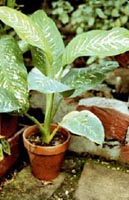Resource Library
Plant of the Week: Dumbcane
The University of Arkansas System Division of Agriculture does not promote, support or recommend plants featured in "Plant of the Week." Please consult your local Extension office for plants suitable for your region.
Plant of the Week
Dumbcane
Latin: Dieffenbachia seguine

Darwin taught us the principles of "survival of the fittest," but only as it occurs in nature. Every winter, gardeners continually retest his theory by identifying plants that will, or quite often will not, survive the low light and dry heat of our homes.
One of the survivors of this struggle is dumbcane, Dieffenbachia seguine and its many varieties.
Dumbcane, a native of tropical Brazil, is one of the old fashioned Victorian houseplants that found its way into our parlors during the 19th century. In intervening years it has been hybridized to produce plants with showier leaves and more compact forms.
Dumbcane can reach 6-8 feet high with the 18-inch long leaves clustered at the ends of the stout, segmented trunks which will often be 2 inches or more in diameter. The leaves have natural variegation patterns which can be made larger or smaller by breeding, thus giving rise to the many selections in the marketplace.
The most common cultivar is "Amoena," which has cream colored, finger-shaped blotches equally spaced down the length of the leaves.
Propagation of dieffenbachia has changed in the last 20 years as Florida growers embraced tissue culture. By using sterile, test tube culture and hormone manipulation they have been able to propagate countless numbers of these old fashioned plants and grow them in smaller containers.
The modern day dieffenbachia is grown in a 6-inch pot and, unlike its predecessors that were propagated by cane cuttings or layering, it suckers freely and produces a number of short
stems which are topped by numerous, smaller leaves. Eventually, the plant will resume its upward growth and one cane will dominate, but it may take several years for this to occur.
The name dumbcane is fitting, because the juice from this plant can truly strike you dumb. Dieffenbachia belongs to the philodendron family and many members of this family produce crystals of calcium oxalate in the cell sap. If the plant is ingested or sap on the fingers is rubbed near soft tissue around the eyes or nose, you immediately know you have a problem.
The crystals penetrate the cells and cause burning and inflamation of the tissue. Symptoms usually are short lived, but can, in severe cases, persist for up to 48 hours. Recent research indicates that it is not the tiny crystals that cause the problems but a protein called asparagine, which enters the cells when they are punctured by the crystals.
Dieffenbachia is on every poisonous plant list ever published, yet I have been unable to locate any cases of death associated with the plant. Certainly, dumbcane should be kept out of the reach of the small, exploring hands of toddlers, but there is no evidence it is dangerous to have around the house.
Dumbcanes are easy to grow given average winter-time temperatures and just routine care. Plants are able to flourish with light levels of 25 ft-c, close to what might be considered mood lighting. The soil should be allowed to dry somewhat between waterings, but not become bone dry. When good light conditions arrive during the spring and in the summer, fertilize monthly with a soluble houseplant fertilizer.
Eventually dieffenbachia will resemble a palm tree and be too tall and spindly to be very attractive. When that happens, air layer the top and start a new plant. The old plant can be cut back to a stub to regrow from the base. Spider mites are the only serious pest likely to be seen on dumbcane.
By: Gerald Klingaman, retired
Extension Horticulturist - Ornamentals
Extension News - January 11, 2002
The University of Arkansas System Division of Agriculture does not maintain lists of retail outlets where these plants can be purchased. Please check your local nursery or other retail outlets to ask about the availability of these plants for your growing area.